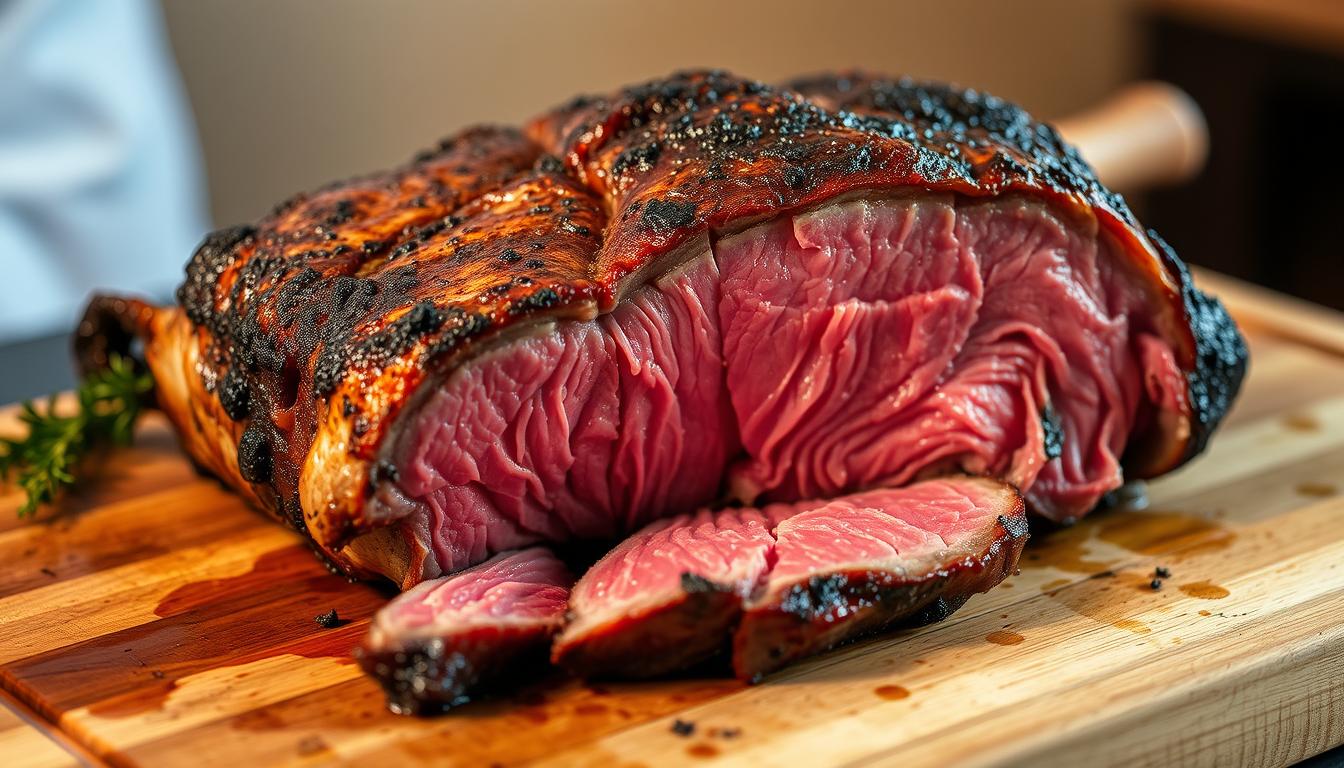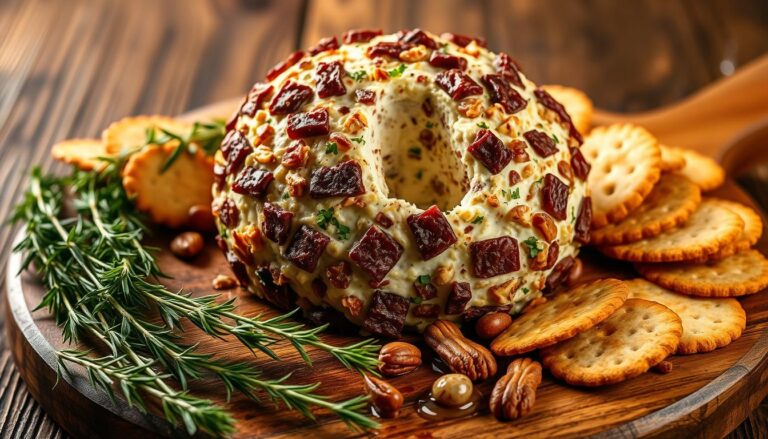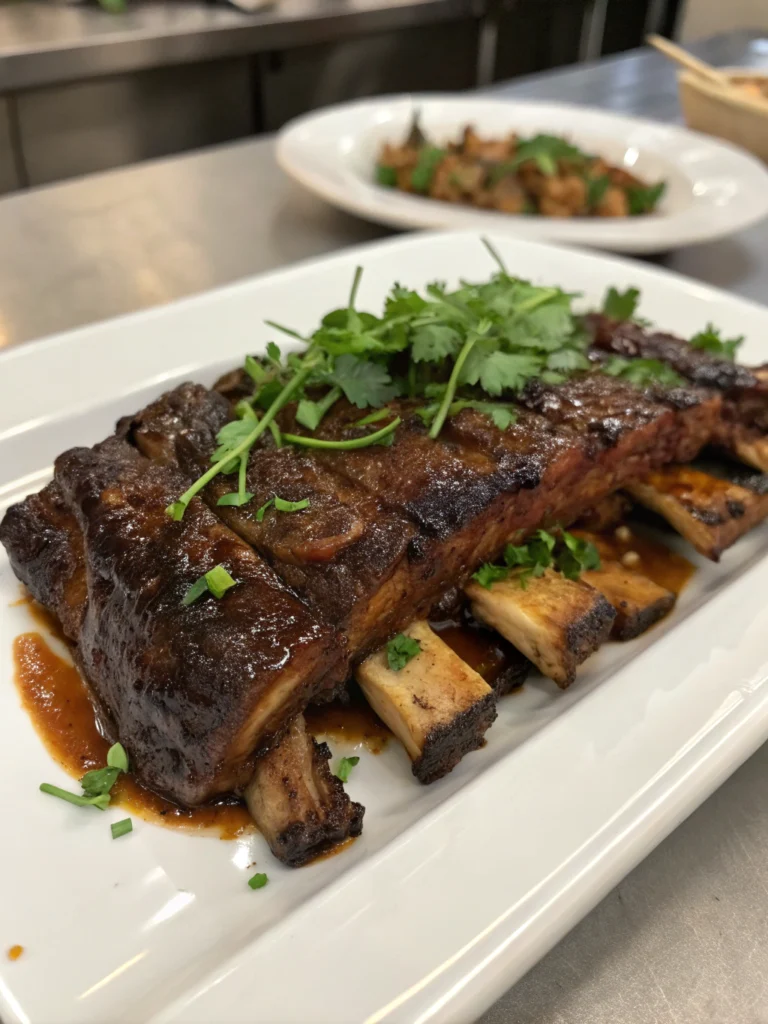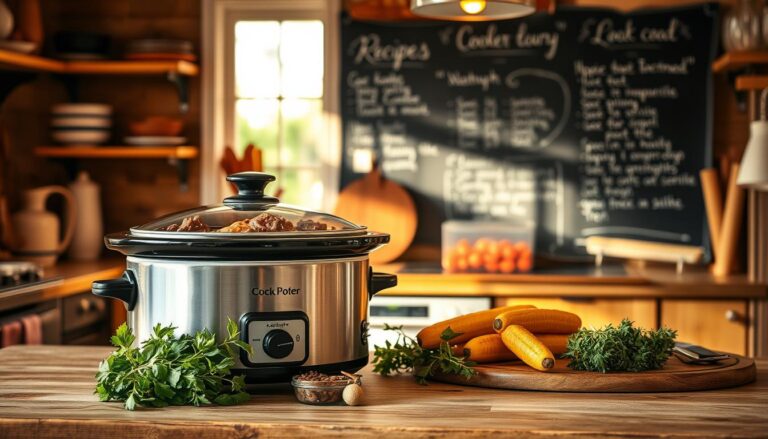Beef Ribeye Roast Recipe: 8 Delicious Ways to Cook It
What if you could create a restaurant-quality dinner at home in just over an hour? Imagine serving a dish that’s tender, flavorful, and sure to impress your guests. This recipe makes it possible, turning a simple roast into the star of your table.
With a total cook time of 1 hour and 40 minutes, this dish is surprisingly easy to prepare. The marbled texture of the meat ensures it stays juicy and rich in flavor. Whether you’re hosting a special occasion or simply treating yourself, this rib roast delivers perfection every time.
Ready to elevate your cooking game? Keep reading to discover expert tips and step-by-step instructions that will make this recipe a staple in your kitchen.
Key Takeaways : Beef Ribeye Roast Recipe
- Create a restaurant-quality dinner at home with minimal effort.
- Enjoy tender, flavorful meat that’s perfect for any occasion.
- Prepare the dish in just 1 hour and 40 minutes.
- Learn expert tips for achieving the best results.
- Impress your guests with a visually stunning presentation.
Introduction to a Flavorful Dinner Experience
Transform your dinner table into a gourmet experience with this standout dish. It’s more than just a meal—it’s a celebration of flavor, simplicity, and tradition. Whether you’re hosting a special event or enjoying a quiet evening, this dish promises to impress.
Why This Dish Stands Out
What makes this dish unforgettable? It’s the perfect blend of butter, seasoning, and technique. Using a high-quality pan and precise oven settings, you can achieve a result that’s juicy, tender, and bursting with flavor. The quick prep time—just 10 minutes—makes it ideal for busy schedules.
A Brief Story Behind the Dish
This recipe has roots in classic culinary traditions. Passed down through generations, it’s a testament to the power of simple ingredients and careful preparation. The use of butter and a well-chosen pan ensures that every bite is rich and satisfying. It’s a dish that brings people together, creating memories around the table.
By mastering the balance of time and temperature, you can recreate this restaurant-quality meal in your own kitchen. It’s not just about cooking—it’s about crafting an experience that your guests will cherish.
Ingredients You Will Need
Gather the right ingredients to craft a dish that’s both simple and extraordinary. The foundation of any great meal lies in the quality of its components. Start with a 4-pound bone-in ribeye, ensuring it’s fresh and well-marbled for maximum flavor and tenderness.
Next, focus on the herbs and spices. You’ll need 6 cloves of minced garlic, 1 tablespoon of salt, 1 teaspoon of cracked black pepper, and 2 tablespoons of fresh rosemary. These ingredients work together to create a robust flavor profile that complements the natural richness of the meat.
Don’t forget the butter. One cup of softened butter is essential for basting, adding moisture, and enhancing the overall taste. It also helps achieve a beautiful golden crust during the cooking process.
Essential Components for Success
A high-quality roasting pan is a must-have for this dish. It ensures even heat distribution and proper browning, giving your meal a professional finish. Look for a pan that’s sturdy and large enough to accommodate the size of your meat.
Each ingredient plays a vital role in building the perfect flavor. The garlic adds depth, the rosemary brings a fragrant aroma, and the butter ties everything together with its richness. Together, they transform a simple cut into a culinary masterpiece.
By gathering these essentials, you’re setting yourself up for success. With the right tools and ingredients, you’ll create a dish that’s as impressive as it is delicious.
Essential Equipment and Preparation Tools
The right tools can make all the difference in achieving a perfectly cooked dish. From your oven to the roasting pan, each piece of equipment plays a vital role in ensuring your meal turns out just right. Let’s explore the essentials you’ll need for success.
Oven and Roasting Pan Selections
A high-quality oven is the backbone of this dish. It ensures even heat distribution, which is crucial for achieving a golden crust and juicy interior. Look for an oven with precise temperature control to avoid overcooking or undercooking.
Your roasting pan is equally important. Choose one that’s sturdy and large enough to accommodate a 4- to 5-pound cut. A good pan promotes proper browning and prevents sticking, making the cooking process smoother.
Using a Meat Thermometer for Perfect Doneness
Timing is key, but a meat thermometer takes the guesswork out of the equation. Insert it into the thickest part of the meat to monitor its internal temperature. This ensures your dish is cooked to perfection, whether you prefer it medium-rare or well-done.
By using these tools correctly, you’ll achieve a flawless result every time. Remember, careful handling and attention to detail are just as important as the equipment itself.
Understanding the Beef Ribeye Roast Recipe
Mastering the art of cooking a flavorful dish requires understanding the techniques that bring out its best qualities. Each step in the process plays a crucial role in achieving a tender, juicy result. Let’s dive into the key methods that make this dish a standout.
Key Cooking Techniques Explained
Seasoning is the foundation of flavor. A mix of salt and pepper enhances the natural richness of the meat. These ingredients work together to create a balanced taste profile that complements other components like garlic and rosemary.
Searing is another essential step. By browning the surface at high heat, you lock in moisture and develop a flavorful crust. This technique ensures the meat stays juicy during the slow roasting process.
Slow roasting is where the magic happens. Cooking at a lower temperature allows the meat to cook evenly, resulting in a tender texture. Using a thermometer is critical here. It helps you monitor the internal temperature, ensuring the dish is cooked to perfection.
Understanding the physics behind cooking is also important. Heat distribution and timing are key factors. For example, cooking at 325°F allows the meat to reach the desired doneness without drying out.
| Technique | Purpose | Key Tool |
|---|---|---|
| Seasoning | Enhances flavor | Salt, pepper, herbs |
| Searing | Locks in moisture | High-heat pan |
| Slow Roasting | Ensures tenderness | Oven, thermometer |
By combining these techniques, you can create a dish that’s both flavorful and visually appealing. Each step builds on the last, resulting in a meal that’s sure to impress.
How to Prepare Your Roast Step-by-Step
Preparing a delicious meal starts with the right steps. Follow this guide to ensure your dish turns out perfectly every time. From preheating your oven to seasoning, each step is designed to make the process simple and effective.
Preheating and Seasoning Tips
Begin by preheating your oven to 500°F. This high temperature ensures a strong start, helping to create a flavorful crust. Once preheated, reduce the temperature to 325°F for even cooking.
Next, prepare your seasoning mix. Combine minced garlic, salt, pepper, and fresh rosemary. Rub this mixture generously over the meat, ensuring every part is covered. This step is crucial for building a rich flavor profile.
Let the meat sit at room temperature for about 30 minutes before cooking. This allows it to cook more evenly and retain its juiciness. Pat it dry with paper towels to ensure the seasoning sticks well.
- Preheat your oven to 500°F for a strong start.
- Rub the meat with a garlic butter mixture for enhanced flavor.
- Let it come to room temperature for even cooking.
- Pat it dry to ensure the seasoning adheres properly.
Safety is key during preparation. Always use clean utensils and surfaces to avoid contamination. Keep raw meat separate from other ingredients to maintain hygiene.
By following these steps, you’ll set the stage for a meal that’s both flavorful and perfectly cooked. Each detail matters, from preheating to seasoning, ensuring a successful outcome.
Cooking Methods for a Perfect Roast
Achieving the perfect texture and flavor in your dish hinges on the cooking methods you choose. Each technique plays a unique role in enhancing the final result, from creating a flavorful crust to ensuring tender, juicy meat. Let’s explore how searing and slow roasting work together to deliver a standout meal.
Searing vs. Slow Roasting
Searing at high heat is the first step to developing a rich, caramelized crust. This method locks in moisture and enhances the overall flavor profile. It’s ideal for creating a visually appealing exterior while preserving the meat’s natural juices.
Slow roasting, on the other hand, focuses on even cooking at a lower temperature. This technique ensures the interior remains tender and juicy, while the exterior stays perfectly browned. Combining these methods allows you to achieve a balance of texture and flavor that’s hard to beat.
Maintaining Optimal Oven Temperature
Controlling the oven temperature is crucial for consistent results. Start with a high heat for searing, then reduce it for slow roasting. This approach helps lock in flavor while ensuring the meat cooks evenly.
Using a meat thermometer is essential for monitoring the internal temperature. It ensures the dish reaches the desired doneness without overcooking. For bone-in cuts, this is especially important to achieve uniform results.
By mastering these techniques, you’ll create a dish that’s both flavorful and perfectly cooked. The right combination of searing and slow roasting transforms a simple meal into a culinary masterpiece.
Time Management and the Cooking Process
Efficient time management is the secret to a stress-free cooking experience. By planning each step carefully, you can ensure your dish turns out perfectly every time. From setting timers to resting the meat, every detail matters.
Setting Your Timer Correctly
Start by setting a timer for the high-heat searing phase. This step typically takes about 15 minutes and helps lock in flavor. Once the searing is complete, reduce the heat and set another timer for the slow roasting phase. This ensures even cooking without overcooking.
Resting the meat is just as important as cooking it. After removing it from the oven, cover it loosely with foil. This allows the juices to redistribute, resulting in a tender and flavorful dish. Aim for a resting time of 15 to 30 minutes.
Multitasking and Avoiding Pitfalls
While the meat is cooking, use the time to prepare side dishes or set the table. This keeps you organized and reduces last-minute stress. However, avoid overloading yourself with too many tasks at once. Focus on one thing at a time to maintain quality.
- Set timers for each cooking phase to stay on track.
- Use foil to retain heat and moisture during resting.
- Prepare side dishes while the meat cooks.
- Avoid common mistakes like skipping the resting phase.
By following these strategies, you’ll master the art of time management in the kitchen. The result? A delicious, stress-free meal that impresses every time.
Tips for Achieving a Juicy and Flavorful Roast
Crafting a juicy and flavorful dish is easier than you think with the right techniques. From seasoning to resting, every step plays a crucial role in ensuring your meal turns out perfectly. Let’s dive into expert tips and common mistakes to avoid.
Expert Pro Tips on Seasoning and Resting
Seasoning is the foundation of flavor. Use a mix of salt pepper, minced garlic, and fresh rosemary to create a robust taste profile. Rub the mixture evenly over the meat to ensure every bite is packed with flavor.
Resting is just as important as cooking. After removing the dish from the oven, let it rest for 15 to 30 minutes. This allows the juices to redistribute, preventing dryness and enhancing tenderness.
Avoiding Common Mistakes
One of the most common mistakes is over-handling the meat. Avoid pressing or cutting it too soon, as this can cause juices to escape. Instead, let it rest undisturbed for the best results.
Another pitfall is skipping the use of a meat thermometer. Monitoring the internal temperature ensures the dish is cooked to perfection, whether you prefer it medium-rare or well-done.
- Season evenly with salt pepper and fresh rosemary.
- Rest the meat to retain moisture and tenderness.
- Use a thermometer to monitor the internal temperature.
- Pair with sides like roasted potato for a balanced meal.
| Mistake | Solution |
|---|---|
| Over-handling the meat | Let it rest undisturbed after cooking. |
| Not using a thermometer | Monitor the internal temperature for accuracy. |
| Inadequate seasoning | Use a mix of salt pepper and herbs like rosemary. |
By following these tips, you’ll create a dish that’s juicy, flavorful, and sure to impress. Pair it with roasted potato or other sides for a complete and satisfying meal.
Serving Suggestions and Ideal Side Dishes
Elevate your dining experience with perfectly paired sides that complement your main dish. The right accompaniments can transform a simple meal into a feast, balancing flavors and textures for a memorable experience. Whether you’re hosting a special occasion or enjoying a quiet day, these serving suggestions will help you create a well-rounded plate.
Start by considering the richness of your main dish. Pair it with sides that enhance its flavor without overpowering it. Mashed potatoes, for example, provide a creamy contrast to the savory notes of your steak. Grilled vegetables add a fresh, smoky element, while warm artisan bread completes the meal with a satisfying crunch.
Pairing with Hearty Sides
When choosing sides, think about balance. Creamy mashed potatoes are a classic choice, offering a smooth texture that complements the meat. For a healthier option, try roasted garlic butter vegetables. They add color and flavor to your plate, making it visually appealing.
Artisan bread is another excellent addition. Serve it warm with a side of herb butter for a touch of indulgence. If you’re looking for something unique, consider a fresh salad with a tangy vinaigrette. It provides a refreshing contrast to the richness of the main dish.
For leftovers, get creative. Transform them into sandwiches for a quick and delicious meal the next day. Use crusty bread, add some greens, and drizzle with a flavorful sauce for a satisfying lunch or dinner.
| Side Dish | Flavor Profile | Pairing Tip |
|---|---|---|
| Mashed Potatoes | Creamy, buttery | Add roasted garlic for extra flavor. |
| Grilled Vegetables | Smoky, fresh | Use seasonal veggies for variety. |
| Artisan Bread | Crusty, warm | Serve with herb butter. |
Plating is just as important as the food itself. Arrange your steak as the centerpiece, surrounded by colorful sides. Use a large plate to avoid overcrowding, and garnish with fresh herbs for a professional touch. These small details can make a big difference in presentation.
For more inspiration, check out a video tutorial on plating techniques. It’s a great way to learn new ideas and improve your skills. Remember, the goal is to create a balanced plate that highlights the main dish while complementing it with thoughtful sides.
By following these tips, you’ll take your meal to the next level. Every step, from choosing sides to plating, contributes to a dining experience that’s both delicious and visually stunning.
Nutrition Information and Dietary Considerations
Understanding the nutritional value of your meal can help you make informed choices. Whether you’re tracking calories or managing dietary restrictions, knowing the details ensures a balanced and satisfying experience.
Caloric Breakdown and Macronutrients
Each serving of this dish contains approximately 472-721 calories, depending on the portion size. The macronutrient breakdown includes 35-45 grams of fat, 40-50 grams of protein, and a moderate amount of sodium. These values make it a hearty option for those seeking a nutrient-dense meal.
Herbs like thyme play a significant role in enhancing flavor without adding extra calories. A small amount of this herb can elevate the taste profile, making it a healthier alternative to heavy sauces.
Dietary Substitutions and Modifications
For those with dietary restrictions, there are simple swaps to consider. Use dairy-free butter if you’re avoiding lactose, or opt for paleo-friendly seasonings to align with specific dietary plans. These adjustments ensure the dish remains inclusive and adaptable.
- Use dairy-free butter for lactose-sensitive diets.
- Replace traditional sauces with herb-based alternatives.
- Choose paleo-friendly seasonings for specific dietary needs.
Portion Control and Balanced Meal Planning
Managing portion sizes is crucial for maintaining a balanced diet. A typical serving should be around 6-8 ounces, paired with nutrient-rich sides like roasted vegetables or a fresh salad. This approach ensures you enjoy a satisfying meal without overindulging.
Transparency in nutritional data is essential. Comparing facts from multiple sources helps you make informed decisions. Always check labels or consult reliable resources for accurate information.
| Nutrient | Amount per Serving |
|---|---|
| Calories | 472-721 |
| Fat | 35-45g |
| Protein | 40-50g |
| Sodium | Moderate |
By focusing on these details, you can enjoy a flavorful meal while staying mindful of your nutritional goals. Herbs like thyme and careful portioning ensure every bite is both delicious and health-conscious.
Conclusion
Bringing a gourmet experience to your kitchen is simpler than you think. By following the step-by-step process and using the right techniques, you can create a meal that rivals any restaurant. Proper seasoning, managing heat, and resting the dish are just a few tips that ensure a flavorful result every time.
Investing in quality tools, as recommended by your butcher, can make a significant difference. These small details elevate your cooking, turning it into a professional-level experience. Don’t be afraid to experiment with new flavors and techniques to make the dish your own.
We encourage you to try this recipe and share your success stories. Whether it’s a family dinner or a special occasion, this meal is sure to impress. Remember, the key to perfection lies in attention to detail and a passion for great food.








One Comment